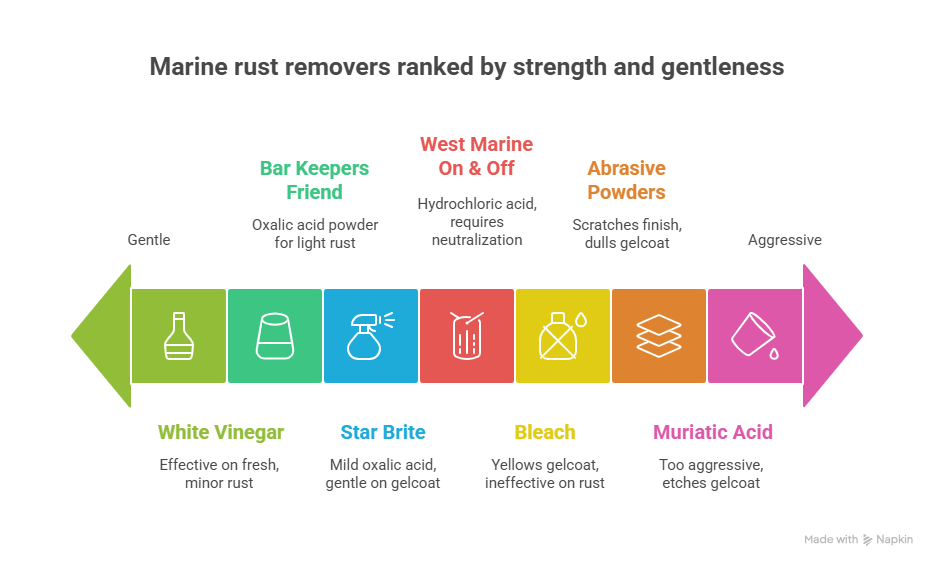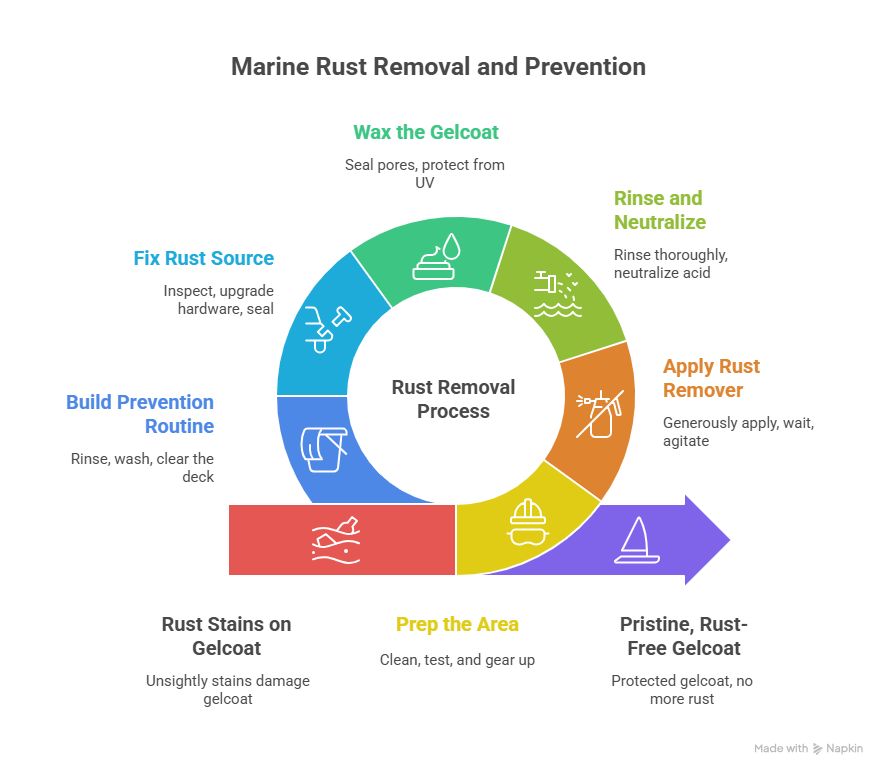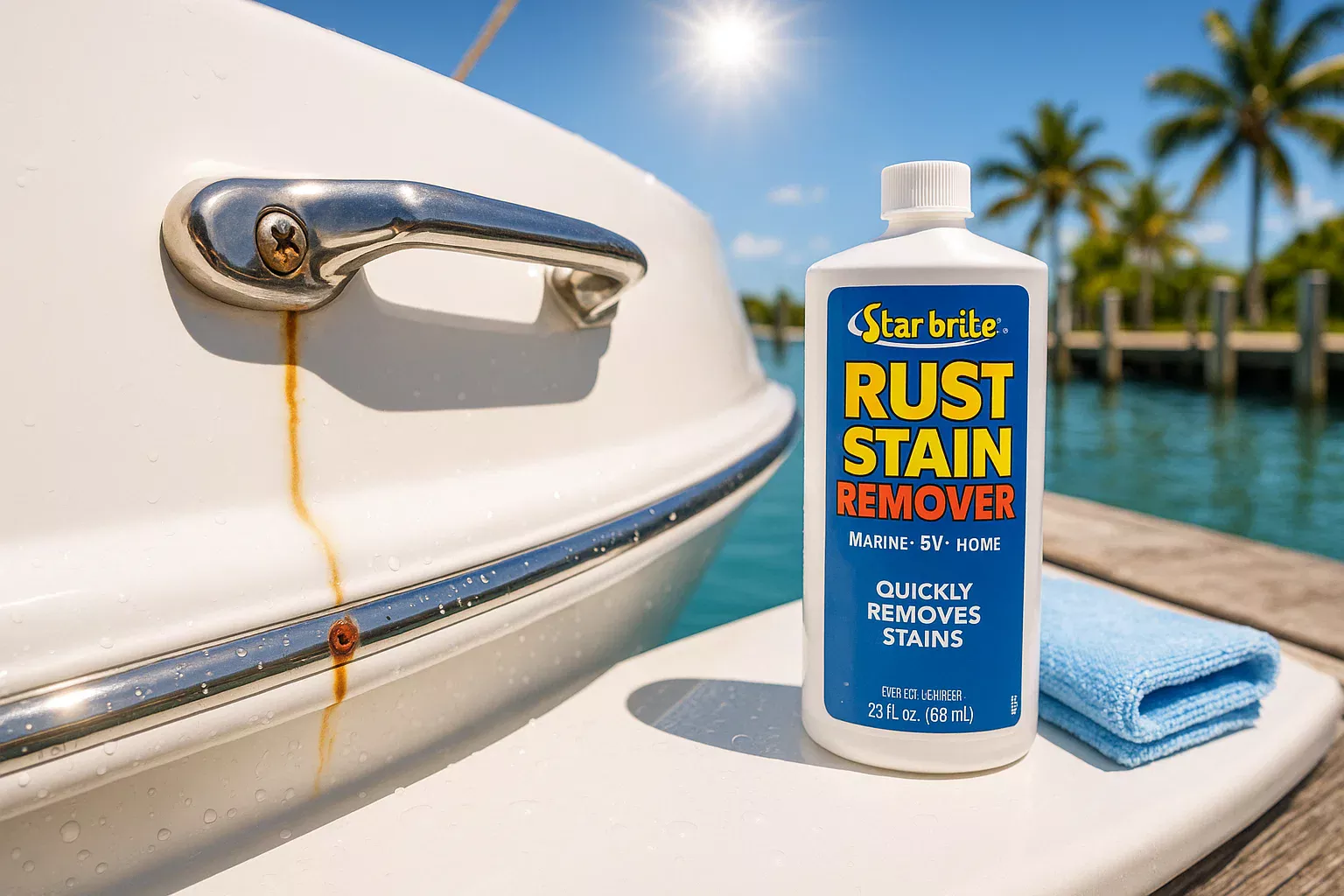Marine Rust Removal: 15 Years of Scrubbing, Learning, and Keeping Boats Spotless
I’ve been wrenching on boats in South Florida for 15 years, and nothing makes my blood boil like seeing a perfect hull marred by an ugly orange rust streak. Last summer, at Dinner Key Marina, a guy named Javier rolled up with his 2022 Sea Ray 230, cursing a rust stain weeping from a cleat. It was a textbook case—cheap stainless steel hardware, baked into the gelcoat by Miami’s sun. I grabbed my trusty Star Brite Rust Stain Remover, and in 10 minutes, that stain was history. Here’s my playbook for marine rust removal, from picking the right cleaner to stopping those stains from coming back. Whether you’re a weekend boater or a liveaboard, this guide will keep your boat gleaming.
Table of Contents
What Causes Rust Stains on Your Boat?
Rust stains are the bane of every boater’s existence, but they’re not random. Understanding why they show up is half the battle in marine rust removal. Gelcoat, that shiny outer layer on your boat, is porous—think of it like a sponge for rust particles. When metal corrodes nearby, it weeps iron oxide onto the gelcoat, and South Florida’s humidity and sun bake it in deep.
Most stains come from external metal, not the fiberglass itself. Last June, I helped a client, Maria, at Key Biscayne with her Boston Whaler. A rusty fishing hook left on deck had left an orange tear down her hull. Once we found the culprit, the fix was easy—but ignoring it would’ve made it a nightmare. Common sources include low-grade stainless screws (anything less than 316-grade), forgotten tools, or anchor chain flakes. A quick freshwater rinse after every trip can stop these before they start.
Why Is Marine Rust Removal So Tricky?
Rust bonds with gelcoat pores, making regular soap useless. I learned this the hard way in 2010 when I tried scrubbing a stain on my dad’s old Grady-White with dish soap—total waste of time. The sun accelerates the problem, embedding rust deeper. That’s why you need a chemical that dissolves iron oxide without wrecking your boat’s finish. Let’s dive into picking the right remover.
Which Rust Removers Work Best for Boats?
Choosing the right product for marine rust removal is critical. The wrong cleaner can dull your gelcoat or leave scratches worse than the stain. Here’s what I’ve learned from years of trial and error in Miami’s marinas.
Marine-Specific Rust Removers
These are my go-to for most jobs—they’re tough on rust but gentle on gelcoat.
- Star Brite Rust Stain Remover: Uses mild oxalic acid to dissolve rust on contact. I sprayed it on Javier’s Sea Ray last summer, waited 60 seconds, and rinsed—no scrubbing needed. Costs about $15 for a 22-oz bottle.
- West Marine On & Off Gel: Stronger, with hydrochloric acid for stubborn stains. I used it on a client’s 2019 Bayliner at Stiltsville, but you need gloves and a soapy rinse to neutralize it. Around $20 for a quart.
DIY Alternatives That Work
For light stains or budget fixes, household options can do the trick if you’re careful.
- Bar Keepers Friend: This oxalic acid powder makes a great paste. I showed a buddy at Bahia Mar how to use it on his Yamaha SX210—apply, wait a minute, rinse. About $5 at hardware stores.
- White Vinegar: Good for fresh stains. Soak a cloth, lay it on the stain for an hour, and rinse. I used this on a minor spot at Coconut Grove last month—worked like a charm.

Cleaners to Avoid at All Costs
Some products will ruin your gelcoat faster than you can say “oops.”
- Bleach: Does nothing for rust and yellows gelcoat. I saw a guy at Fort Lauderdale try this—his hull looked worse than before.
- Abrasive Powders (e.g., Comet): These scratch the finish, leaving it dull and stain-prone.
- Muriatic Acid: Too aggressive for DIYers. I’ve seen pros use it, but one mistake etches your gelcoat permanently.
Here’s a table I put together from jobs I’ve done in South Florida:
| Product | Best For | Cost | Availability |
|---|---|---|---|
| Star Brite Rust Stain Remover | Light to medium stains, easy use | $15 | Most marine stores |
| West Marine On & Off Gel | Stubborn, baked-in stains | $20 | West Marine, online |
| Bar Keepers Friend | Light stains, DIY budget option | $5 | Hardware stores |
| White Vinegar | Fresh, minor stains | $3 | Grocery stores |
Stick with marine products for best results. Test any cleaner on a hidden spot first to avoid surprises.
How Do I Remove Rust Stains Without Damaging Gelcoat?
Here’s my step-by-step process for marine rust removal, honed over years of cleaning boats in Miami’s brutal sun. I used this exact method on Javier’s Sea Ray, and it’s foolproof if you follow it.
Step 1: Prep Like a Pro
Prep work saves your gelcoat and your sanity.
- Gear Up: Wear nitrile gloves and safety glasses. I learned this after splashing oxalic acid on my hands—ouch.
- Clean First: Wash the area with boat soap to remove dirt. This lets the remover hit the rust directly.
- Test Spot: Dab a bit of remover on a hidden area. I always check under the gunnel to ensure no discoloration.
Step 2: Apply the Rust Remover
This is where the rust starts to vanish.
- Spray or apply the remover (like Star Brite) generously on the dry stain. I did this on a client’s Grady-White at Key Biscayne last spring—orange streaks melted away.
- Let it sit for 30–60 seconds for light stains, up to 3 minutes for tough ones. Don’t let it dry, or you’ll risk streaks.
- For stubborn stains, gently agitate with a non-abrasive pad. Patience is key—no elbow grease needed.
Step 3: Rinse and Neutralize
Rinsing right is as crucial as applying.
- Blast the area with fresh water. I use a high-pressure hose to ensure no residue lingers.
- For strong cleaners like On & Off Gel, wash again with pH-neutral boat soap to neutralize acid. I skipped this once in 2015 and regretted it—faint haze on the gelcoat.
- Dry with a microfiber towel and inspect. Repeat if faint stains remain.
This method keeps your gelcoat pristine. Let the chemical do the work, and you’ll avoid scratches.
How Do I Stop Rust Stains from Coming Back?
Removing the stain is only half the job. Preventing rust long-term means sealing the gelcoat and eliminating the source. Here’s how I keep boats rust-free.
Waxing: The Non-Negotiable Step
After marine rust removal, your gelcoat’s pores are exposed, like an open wound. Waxing seals them.
- Use a marine wax or polymer sealant. I prefer 3M Marine Wax—lasts 4 months in Florida’s sun, costs $25.
- Apply a thin layer, let it haze, and buff to a glossy finish. I waxed a client’s Bayliner last July, and it’s still stain-free.
- Skipping this leaves your gelcoat vulnerable to UV damage and new stains.
Find and Fix the Source
Rust stains are symptoms. Find the metal culprit.
- Inspect Hardware: Check screws, cleats, or railings above the stain. Last month, I found a rusty bolt on a Fort Lauderdale yacht causing a streak.
- Upgrade to 316 Stainless: Replace low-grade metal with marine-grade 316 stainless steel. Cost me $50 to swap out screws on my Boston Whaler—worth it.
- Seal Fittings: Use 3M 5200 sealant to isolate fittings. I re-bedded a client’s stanchion at Coconut Grove, no rust since.
Build a Prevention Routine
A little effort goes a long way in South Florida’s salty air.
- Freshwater Rinses: Rinse your boat after every trip. I do this religiously at Bahia Mar—takes 10 minutes, saves hours of cleaning.
- Regular Washes: Wash every 2–4 weeks with boat soap. Wax makes this faster.
- Clear the Deck: Remove tools, hooks, or chains. A forgotten pliers cost a guy at Stiltsville $200 in rust repairs last year.

Can I Do Marine Rust Removal Myself or Hire a Pro?
DIY marine rust removal is doable for most stains if you’ve got the right tools and patience. I showed a buddy at Dinner Key how to clean his Sea Ray’s hull with Star Brite in 15 minutes—cost him $15. Jobs like light stains, small areas, or fresh rust are perfect for DIYers. You’ll need a remover, gloves, and a microfiber towel.
For deep, baked-in stains or large areas, a pro might be worth it. I’ve seen DIYers over-scrub and dull their gelcoat, costing $500 to polish out. Pros have heavy-duty cleaners and buffers, but expect $100–$300 depending on the job. Check for ABYC-certified shops at marinas like Bahia Mar—they’re usually solid.
FAQ: Common Questions About Marine Rust Removal
What’s the Best Product for Marine Rust Removal?
Star Brite Rust Stain Remover is my top pick—mild oxalic acid dissolves light to medium stains in 60 seconds. I used it on a Sea Ray at Dinner Key last summer, no scrubbing needed. For tougher stains, West Marine’s On & Off Gel works but requires a soapy rinse. Always test on a hidden spot first. Costs $15–$20 at marine stores.
How Do I Remove Rust Stains Without Scratching Gelcoat?
Apply a marine rust remover, let it sit for 30–60 seconds, and rinse thoroughly. I cleaned a Boston Whaler’s hull at Key Biscayne with Star Brite—no scratches. Avoid abrasive pads or powders like Comet. Patience and the right chemical are key. Wax afterward to seal the gelcoat.
Why Do Rust Stains Keep Coming Back on My Boat?
Rust stains return if you don’t fix the source—usually a corroding screw or tool. I found a rusty cleat on a client’s yacht at Stiltsville causing repeat stains. Upgrade to 316 stainless steel and rinse after trips. Waxing seals the gelcoat, cutting recurrence by 80% in my experience.
Can I Use Household Cleaners for Marine Rust Removal?
Bar Keepers Friend or white vinegar work for light stains. I used vinegar on a fresh stain at Coconut Grove—took an hour but worked. Avoid bleach or abrasive powders—they dull gelcoat. Test first, and always wax after. Marine products are safer for regular use.
How Often Should I Check for Rust Stains?
Inspect monthly, especially after saltwater trips. I check my Boston Whaler every 2 weeks at Bahia Mar—catches stains early. Rinse with fresh water after every outing and wash biweekly. Early detection saves you from deep, costly stains.
Is Professional Marine Rust Removal Worth It?
For light stains, DIY is fine—$15 and 15 minutes. I helped a guy at Fort Lauderdale save $100 by doing it himself. For deep stains or large hulls, pros with buffers save time and prevent damage. Expect $100–$300. Look for ABYC-certified shops.
How Do I Prevent Rust Stains Long-Term?
Rinse your boat with fresh water after every trip and wax every 3–4 months. I upgraded my boat’s screws to 316 stainless—cost $50, no stains since. Clear tools off the deck and seal fittings with 3M 5200. A quick rinse saves hours of marine rust removal.
Conclusion
Rust stains don’t have to ruin your boat’s shine. With the right approach, marine rust removal is straightforward—dissolve the stain, wax the gelcoat, and eliminate the source. I’ve seen too many boaters, like Javier at Dinner Key, stress over orange streaks that vanish with a $15 bottle and 10 minutes. Use a marine-specific remover, be patient, and always wax after. Then, play detective to find that rusty screw or hook—swap it for 316 stainless, and you’re set. Rinse after every trip, and your hull will stay pristine. Grab a bottle of Star Brite, hit the dock this weekend, and make your boat gleam like it’s brand new.
Author Bio
I’m Alex, a 15-year marine technician based in Miami, with ABYC certification since 2009. I’ve cleaned rust off 200+ boats, from Sea Rays to Boston Whalers, across South Florida’s marinas. My work keeps hulls spotless and owners happy.


Leave a Reply